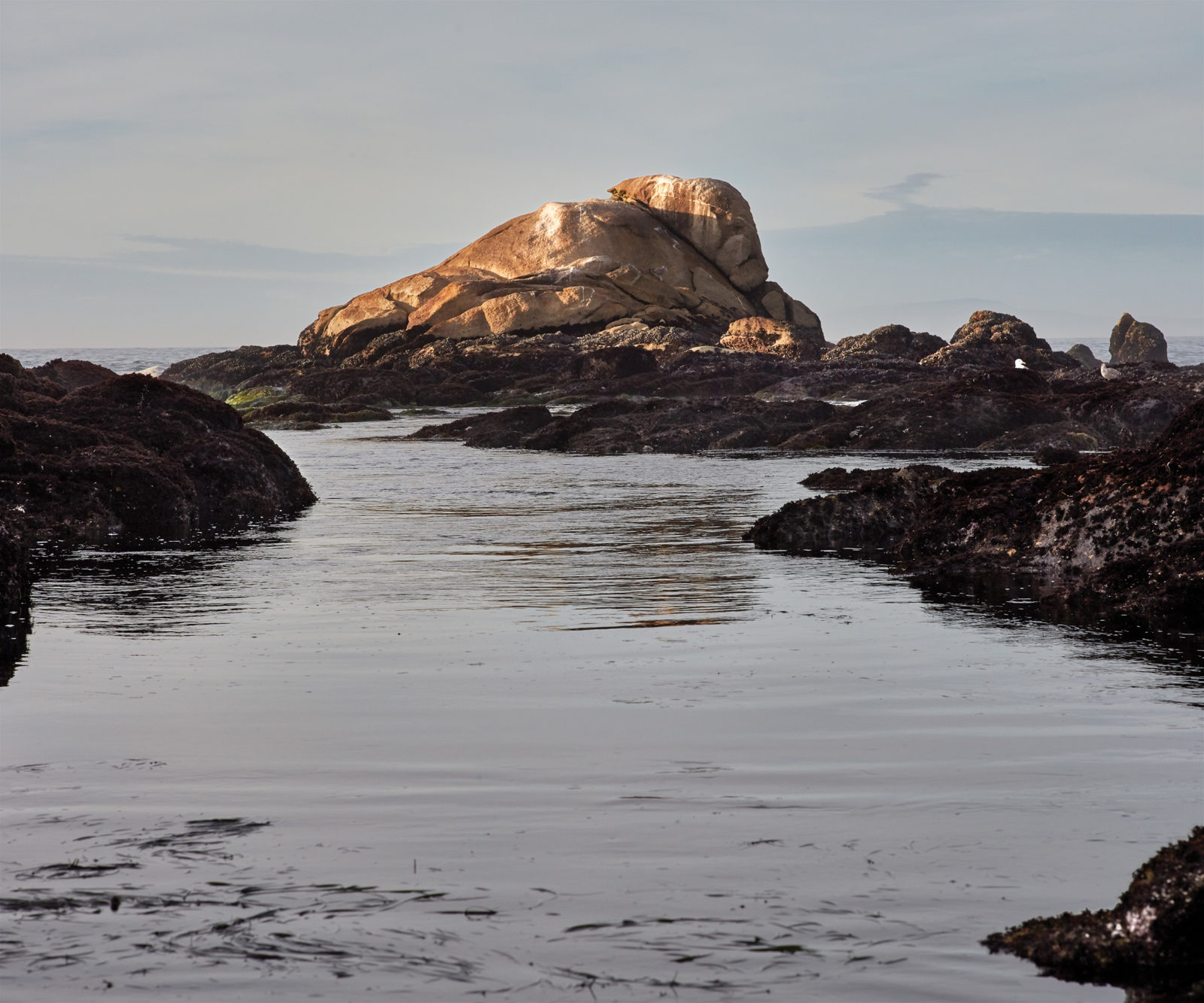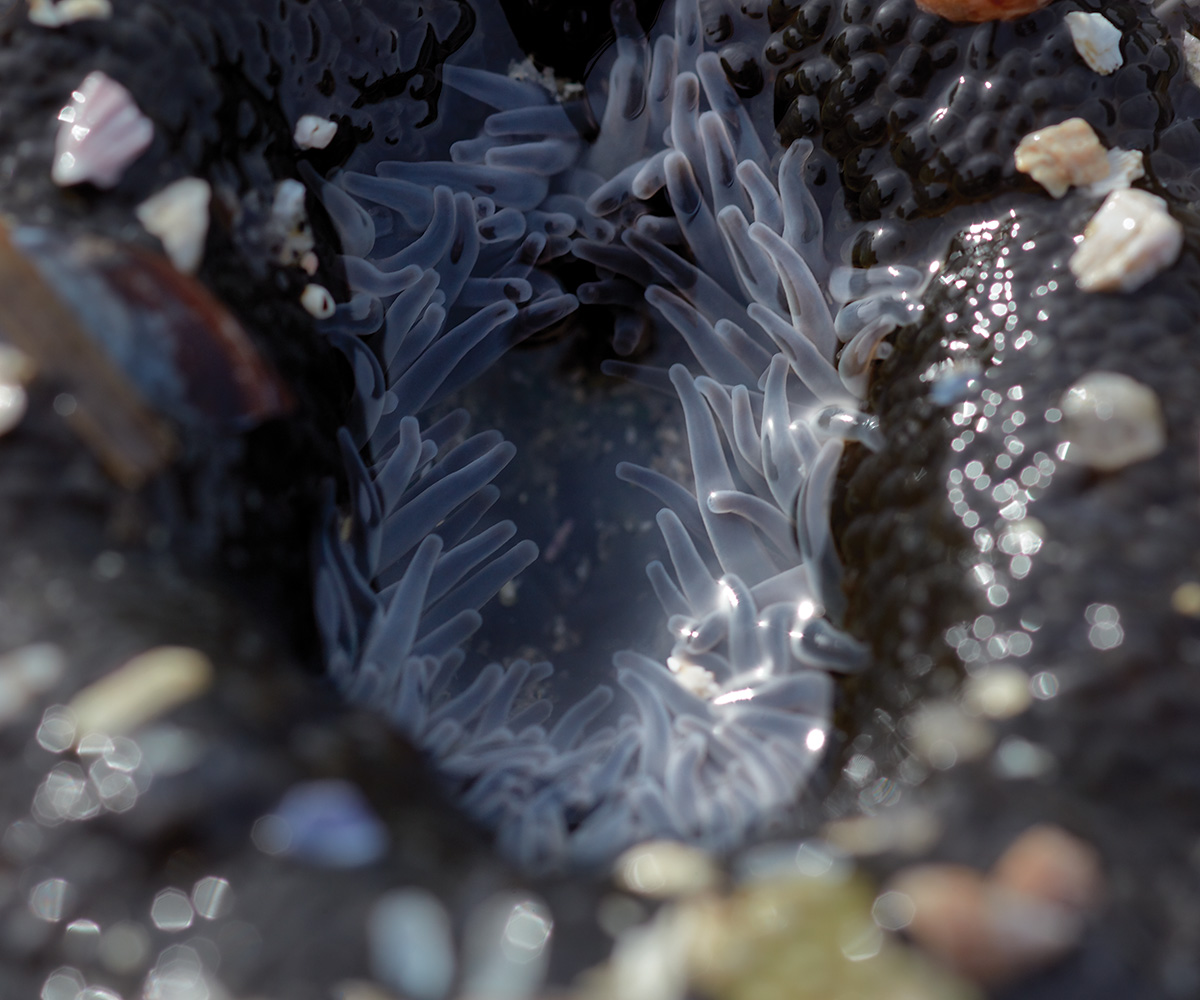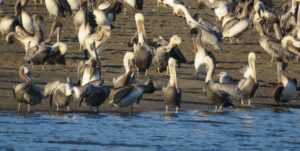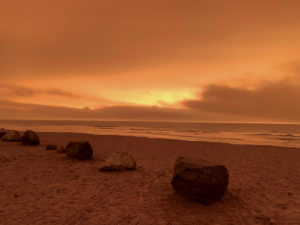
Behind the Hopkins Marine Station in Pacific Grove a crown of granite pushes out northeast into Monterey Bay, the sea-drenched rock slabs leaning at angles against each other like a giant tumbled set of children’s blocks. In the deep fissures, cracks, and channels, the blue water sloshes through. Otters splash into the shallows, egrets and herons stand still in the water, gulls and oystercatchers perch on the mounds of seaweed that pile on the lower rocks. On the smooth, rounded tops of the higher rocks, cormorants spread their wings like decorative gargoyles.
The day we visited, Jim Barry walked a dusty path through ice plant to the edge of the bluff overlooking the tidepools. It’s a scramble down a head-high drop from the bluffs to the beach, onto a thick layer of broken shells that crunch near the water’s edge. The rocks that form the backbone of this tidepool system date to at least 80 million years ago, chunks of granite bumping northwest over the eons. Worn and eroded, they nonetheless feel as eternal as the blue ocean around them. When Barry was a graduate student studying marine biology in San Diego, he would hammer metal bolts into the rock to mark off tidepool areas to study. But working with the crumbling and constantly shifting sandstone of the tidepools of La Jolla was like drilling into drywall. “Granite,” he said, appreciatively noting the contrast now. “It’s here forever.”
When he was in fourth grade Barry’s mom took him to Stinson Beach, and the ocean caught him there. The day he turned 16, he told us, he got his driver’s license and drove to the beach to go surfing. Barry’s mother worked at Stanford, and through her he met an Antarctic researcher, who offered Barry a summer job cleaning bathrooms and assisting field researchers with penguin tagging. Barry went, and returned from the Antarctic with a real appreciation for the science life and “much more interested in school.”
In 1991, after earning a Ph.D. from the Scripps Institute of Oceanography, Barry moved back north to work at the Monterey Bay Aquarium Research Institute. Early in his career he spent some of his time down here on the rocky shore looking into these pools. But when we met this year, it had been almost 25 years since he worked regularly in this exact tidepool, and he spent half an hour slowly reacquainting himself with what he saw. He remembered the giant green anemones, Anthopleura xanthogrammica, and told us they might live to be 100 years old, staying relatively close to home, probably within one pool, for their entire lives. Over the last few decades, a species called the sunburst anemone, Anthopleura sola, identifiable by the striking lines radiating out from its central disc, has been taking over more space in the tidepools. Barry felt too like there were more of the giant pink barnacles called Tetraclita than there’d once been. He commented on the color of the purple-brown algae mats clumped over the rock. Change in a tidepool may be subtle, aesthetic really, but noticeable to the trained eye.
Barry’s career turned long ago from tidepool studies to investigating the deep sea. Visiting the tidepools now reminded him of the transient nature of the seashore. It’s an entire universe here in the shallows, rocks and sun and water, forests and shrubs and meadows, grazers and hunters, all fully contained in a few hundred feet of rock and reset twice a day with the tide, like a system working in fast forward.
“When I come here,” Barry said, “I see what’s changing.”
Change is rarely so evident in the ocean as it is on land. Tidepools, where people have observed, collected, and contemplated for millennia, have become measuring sticks for the ocean. Our connection to them stretches back, some say, to the dawn of the modern human mind. Tidepools have trained philosophers, scientists and naturalists to understand the workings of the wider world. And in part because of what Barry and colleagues did here a few decades ago, this particular tidepool holds international renown. Beneath the eternally blue surface, in the pools around its timeless granite, this tidepool gives us an opportunity to bear witness to change.

In 1931 a graduate student named Willis G. Hewatt arrived in Monterey to study the arrangement of animals in the tidepool we were standing in. For roughly three years he counted and categorized all the tidepool inhabitants living along a transect delineated by a series of four bolts he’d driven into the granite. The study site, stretching from a nearshore boulder below the marine station to a large mussel bed 324 feet out into the tidepools, later became known as Hewatt’s transect. No one grasped its significance at the time. Upon the conclusion of his work in 1935, Hewatt filed his dissertation and moved home to Texas. Mats of seaweed soon grew thick over the transect bolts.
When Jim Barry started out at MBARI, he would often make the short walk from his office down to Hopkins to talk with the lab’s resident elder, Chuck Baxter, who’d been lecturing to Stanford students at the marine station since the 1970s. One time, Baxter mentioned to Barry that he felt like things had changed in the tidepools out the window. He looked out at the water pouring through the rocks and he felt something about it looked like Southern California. They got to talking. Baxter had been thinking already about the Hewatt transect, and now he wanted to return to it. According to the predictions of the still-new science of global warming, you would expect marine creatures to move north toward colder water at the pole. Maybe Baxter’s gut feeling that he saw Southern California out the window had a basis, one that Hewatt’s historic descriptions of the tidepool might allow observers to unveil.
In 1993, two Stanford undergraduates, Raphael Sagarin and Sarah Gilman, accepted a pitch from Baxter to work with him on uncovering and re-surveying the transect. Baxter recruited Barry to join them. Hewatt had recorded his tidepool creatures in one-yard squares centered on each of the four bolts along the line. To make their new study work, the scientists would have to find the exact inch-wide bolts that Hewatt had drilled into the rock 60 years earlier and that almost no one had seen since. So Sagarin, Gilman, Baxter, and Barry searched for the long-buried metal. Barry remembers being out at a low tide in the middle of the night, Coleman lanterns casting the granite in sharp relief, pushing piles of seaweed aside to sweep the exposed rock with metal detectors. They recovered them eventually, and then the work could begin.

Neither of the undergraduates had any idea that this project would launch their careers. Gilman, now a marine ecologist at Claremont Colleges in Southern California, says she had no particular tilt toward the ocean. She’d heard Baxter’s idea in her first marine biology class. Two years later she would appear on CNN to talk about her work. Five years later Sagarin would show this tidepool to the president and vice president of the United States.
During low tides that year Gilman and Sagarin would lay down a one-yard-square box at each bolt and count and identify everything within it. By the end of the spring they had documented 58,000 individual animals. The next step was to compare what they’d counted to the species and positioning Hewatt had described 60 years earlier.
In a 1995 article in Science, Barry, Baxter, and the just-graduated Gilman and Sagarin reported that the abundance of eight of nine warm-water southern species had increased at the site, while five of eight cold-water northern species had decreased since 1935. The shift coincided with measurements showing that the water at the site had warmed over the decades, as a result of climate change.
At the time, even the authors didn’t realize the long-term significance of their study. For centuries, western scientists and writers had described the ocean as so vast as to be beyond the human ability to disturb. Barry, Baxter, Gilman, and Sagarin arrived with evidence at a turning point in the scientific relationship to the ocean. Other scientists had just begun to grapple with the implications of global warming, and because the tidepool re-survey had connected the present to the past, it landed with particular heft. Ocean watchers didn’t have to wait to document change—it was already there. “During that period we really started thinking about how marine systems are changing,” Barry said, “and the future is not one of stasis and stability.”
It has been 24 years since that paper. The human pressure on the ocean has only become more and more apparent. Researchers who started watching their own study sites more closely after 1995 have now had time to see slow-moving change of their own. Scientists are trained to be observers. To record and document and measure where we’ve come from. Now, many of them feel like witnesses to decline. The faster and deeper the change, the more we need those anchors in the granite to provide future generations with a map of a world we once knew.

The Native people of Monterey, who now call themselves Rumsen Ohlone, once fished the marshes and rivers for salmon and sturgeon in the winter. They built canoes out of tule to travel Monterey Bay and the ocean. They gathered cormorant eggs from the sea cliffs and rocky islands, and they camped on the sandy beach on nights when the smelt and grunion ran. From the tidepools they harvested mussels, clams, oysters, crabs, and snails. For thousands of years, the Rumsen have made jewelry out of abundant abalone and olivella; the discarded shells of abalone spread so thick on the Monterey Peninsula that modern Pacific Grove still has a layer in the soil, and if you dig in a garden there your shovel will come up sparkling with broken, iridescent shells. The path on which Jim Barry walked us to the tidepool glittered beneath its ice plant canopy.
Linda Yamane did not grow up with this detailed understanding of her Rumsen Ohlone heritage. She was born in 1949 in San José, a few dozen miles north of Monterey, where her father’s mother’s family had survived the mission period and American colonization. Her grandmother told her stories from the late 1800s, but she didn’t know much about Rumsen culture.
In the 1770s Spanish settlers forced the Rumsen and other Northern California Ohlone into missions. In the 1830s, after Mexico became independent from Spain, the missions were secularized and the surviving Ohlone forced out into a world transformed. A decade later American settlers began to arrive and claim land of their own or take it by force. When Native Californians resisted, some of the new American arrivals hunted and killed them. By the time Linda Yamane’s grandmother was an adult, anthropologists had declared the Ohlone extinct, a characterization that contributes to preventing modern-day Ohlones from being recognized as a Native American tribe by the federal government. By the time of Yamane’s childhood, the record that this had been a thriving community of ocean people survived to the general public in the remnant Spanish name, costeños, which had morphed into the anglicized label some people still use for the Ohlone: Costanoan.
As she grew older Yamane’s curiosity about her ancestors increased. But she struggled to find more about them until in 1985, in one of the turning points in her life, someone told her the San José State University library held a treasure trove of mostly unexamined Ohlone information.
In the 1930s, the same years that Willis Hewatt studied invertebrates in Monterey Bay, a small group of Rumsen elders, including the last-known fluent speaker of the language, had tried to tell an ethnographer named John Peabody Harrington everything they remembered: words, places, people, stories. Handwritten in a mix of English, Spanish, and various Ohlone languages, Harrington’s notes went into loosely organized boxes in the Smithsonian and eventually onto microfilm shared with a small number of university libraries. By the time Yamane found them in San José, only a handful of people remembered the history or the record of it.
Later, Yamane wrote about how she felt shy saying her ancestors’ words. She would speak them late at night, sitting awake in her bed while her family slept. From basic words she moved to songs, which she found recorded on wax cylinders in the Phoebe Hearst Museum of the University of California, Berkeley. After studying museum collections and talking to basket-makers from other Northern California tribes, she became the first Ohlone to weave an Ohlone-style basket in more than a century. She became interested in the canoes in which the Rumsen navigated their watery world, and in the 1980s she joined a group to build a tule canoe. For the last few years she has built new canoes for the Monterey Bay Aquarium’s “Turning the Tide” summer program in which they are paddled through the Great Tide Pool, an artificial rocky pool fronting Monterey Bay a few hundred feet south of Hopkins Marine Station.

Yamane taught herself to make Ohlone shell jewelry of olivella and abalone. When it came to the lustrous abalone shell, Yamane knew she could find broken pieces here and there, but acquiring them in the supply she needed was a challenge. A friend in Berkeley would go to the flea market and see abalone shells for sale, buy them up and ship them to Yamane in bulk. Later, she met some abalone divers who emailed around, asking fellow divers if they had discarded abalone shells in their yards. More cardboard boxes, stuffed with shells, arrived. “Maybe one of these days there won’t be abalone shells that people can get ahold of anymore,” Yamane remembered thinking. “Even if it’s after I’m dead, my community will have these.”
Accidentally at first, and then with purpose, Yamane had established herself as a sort of abalone bank.
“At that time I wasn’t thinking about climate change but just about how so many natural resources have become less and less and less over my lifetime,” she told us. “I’m 69; that’s enough years for it to kind of hit you over the head. You see how much things have changed.”
A few hours after visiting the tidepool, where Barry told us about reconstructing the Hewatt transect, we drove across town and had dinner with Yamane to talk about the past and present of Rumsen life. At a small sushi place near her house, she told us about the work it takes to find and revive a lost connection. She wore, as she often does, her abalone earrings.
Yamane expressed her gratitude for the Ohlone who possessed the courage to keep watching and the foresight to record and document their world over centuries of genocide. “Obviously it takes a lot of work on our part,” she later told us. “But the first necessity is that the information is there in some form, that it was preserved.”
You can restore something vital to the world, Yamane said, by taking that documented academic information and turning it into something people can see and touch. That’s how she characterizes her own work and career: half historian, half artist, trying to create new beauty out of past knowledge. “The information itself is tangible but I want to transform that into something three-dimensionally tangible,” she said. “Something you can hold. That, to me, is when it comes to life.”
Linda Yamane and Jim Barry tell different stories about change in the same place. But there is, perhaps, a shared lesson. Rumsen elders, marine scientists, and people who simply love a place deeply know their field areas, their tidepools or their estuaries, in the way we know our neighborhoods. They know the tides, the feeling of a big swell approaching, the shift in the colors on the rocks or in the water. They know the subtle changes in species from tidepool to tidepool and beach to beach, and they understand that without bolts in a rock or notes in a library it becomes so much harder to create or preserve meaning in the world.

For the last 15 years, UC Davis Bodega Marine Lab biologists Jackie Sones and Eric Sanford have walked the beach outside the lab almost every day, looking for interesting life or things to photograph for Sones’s popular natural history blog. In July 2014, Sones and Sanford started to see unusual warm-water species on the beach.
It was the beginning of a two-year “marine heat wave” headlined by an El Niño and a patch of warm water scientists labeled “the Blob,” and they knew this would mean marine animals on the move. Sones had noticed warm-water species washing ashore already: purple striped jellyfish, blue buoy barnacles, and a southern species of siphonophore. These sightings became part of a consolidated list of observations that Sanford and Sones tracked, and Sanford added some of the Monterey species to the list of things to watch for, including the pink barnacles and lined anemones Jim Barry had pointed out to us in the Pacific Grove tidepool.
Sanford and Sones explored museum collections for historical records of species out of place, pulled together citizen science records and expert natural history observations, and folded in oceanographic data. In March 2019, Sanford, Sones, and colleagues published a paper in Scientific Reports documenting changes in 37 species as the heat wave persisted. The sunburst anemone, with its radiating lines on the central disk moving toward the tentacles, is among a handful of species that have made a permanent home in Northern California, long after the impacts of the heat wave dissipated.
They are small, these tidepool inhabitants, and they can live their entire lives clinging to one single rock. They can seem as fixed in place as the tidepool itself. An observer on any single day might never see one move, might never guess at the way a small sessile species can flood its way up a coastline in a great and irrepressible tide. But we witness, and we document, and so we know. The change in the tidepool marches on.




